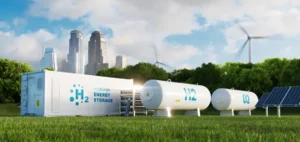The European Union is changing its subsidy criteria for hydrogen projects in response to European manufacturers’ concerns about competition from low-cost Chinese imports.
The new rules will aim to strengthen local electrolyser supply chains and protect data security.
The European Commission’s decision comes as the EU prepares to launch its next round of funding for green hydrogen, with specific targets to boost local production.
European companies in the hydrogen sector, particularly electrolyzer manufacturers, have been warning for several months that they cannot compete with Chinese producers in terms of cost.
These electrolyzers, essential for producing hydrogen by splitting water molecules, are increasingly manufactured outside the EU, often at much lower prices in China.
European players in the sector are calling on the EU to include criteria favoring local companies in its subsidy programs.
Reducing dependence on non-European equipment
The EU’s review of subsidy criteria for hydrogen projects could include requirements on the origin of the equipment used.
According to Wopke Hoekstra, European Commissioner for Climate, these criteria could impose a mandatory share of production and assembly within European borders.
The aim is to ensure that EU-funded projects do not rely excessively on imported components or technologies, particularly when these imports come from aggressively-priced countries.
Current discussions suggest that the Commission is also considering limiting projects that rely on non-European suppliers.
One of the main thrusts of this strategy is to minimize the risk of sensitive European data being exposed to entities outside the EU.
The new guidelines are expected to be applied to the next call for projects under the EU Hydrogen Bank in the coming months.
Cybersecurity rules and market impact
Alongside economic issues, cybersecurity is becoming a central concern.
Hoekstra points out that uncontrolled access to strategic information could pose substantial risks to Europe’s technological sovereignty.
Specific criteria could be incorporated to ensure that projects supported by European grants meet rigorous standards of data management and information protection.
In April, the EU had already allocated 720 million euros to hydrogen projects, but internal critics pointed out that some projects used imported equipment, compromising the strategic objectives of developing a robust local industry.
The new rules aim to rectify these shortcomings by favoring project proposals that demonstrate a clear commitment to European industrial capabilities.
Implications for EU Trade Relations
The review of hydrogen subsidies is part of a wider EU policy to ensure fair competition on its internal market, without resorting to market-closing measures.
While the EU is not seeking to cut ties with China, it is aiming to regulate access to European subsidies to avoid commercial practices deemed unfair.
By imposing stricter criteria, the EU is attempting to stimulate demand for European technologies while protecting its strategic industries from outside pressure.
European manufacturers are particularly vigilant with regard to tariffs and subsidies that could indirectly favor non-European players.
Discussions on new subsidy rules reflect Brussels’ desire to ensure that climate and energy policies also support the continent’s industrial competitiveness.






















